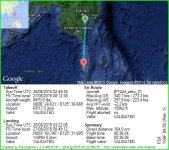The similar Tainan Air Group (also flying mostly A6M2s in 1941-1942) was more famous. It also attacked the Philippines and later fought in the Dutch East Indies, over Lae and Port Moresby, and finally out of Rabaul over the Slot and Guadalcanal in 1942. Most of the original supremely-well-trained pilots were lost during these campaigns, especially the four month air battle over Guadalcanal. When the unit was disbanded, the surviving 10 pilots were sent back to Japan to constitute new fighter units.
Pilots of the Tainan Air Group pose at Lae in June 1942. Several of these aviators would be among the top Japanese aces, including Saburō Sakai (middle row, second from left), and Hiroyoshi Nishizawa (standing, first on left).
Some the very best pilots of the Imperial Japanese Navy Air Service flew for the famous Tainan Air Group Included were Hiroyoshi Nishizawa, Saburo Saki, and Toshio Ota. Here is a story of these three pilots when they flew out of Lae in the Port Moresby campaign, as told by Wikipedia.
Hiroyoshi Nishizawa was a member of the famed "Cleanup Trio" with Saburō Sakai and Toshio Ōta. In the night of 16 May, Nishizawa, Sakai and Ōta were listening at the lounge room to a broadcast of an Australian radio program, when Nishizawa recognized the eerie Danse Macabre of the French composer, pianist and organist Camille Saint-Saëns. Nishizawa, thinking about this mysterious skeleton dance, now suddenly had a crazy idea: "you know the mission tomorrow at Port Moresby? Why don't we perform a little show, a dance of death of our own? We do a few demonstration loops right over the enemy airfield, this should drive them crazy on the ground."
On 17 May 1942, Lieutenant Commander Tadashi "Shosa" Nakajima led the Tainan Ku on a mission to Port Moresby, with Sakai and Nishizawa as his wingmen. As the Japanese formation re-formed for the return flight, Sakai signaled Nakajima, that he was going after an enemy aircraft and peeled off. Minutes later, Sakai was over Port Moresby again, to keep his rendezvous with Nishizawa and Ōta. The trio now performed aerobatics, three tight loops in close formation. After that, a jubilant Nishizawa indicated that he wanted to repeat the performance. Diving to 6,000 ft (1,800 m), the three Zeros did three more loops, still without any AA fire from the ground. They headed then back to Lae, arriving 20 minutes after the rest of the Kōkūtai.
At about 21:00, Lieutenant Junichi Sasai wanted them in his office, immediately. When they arrived, Sasai held up a letter. "Do you know where I got this thing?" he shouted. "No? I'll tell you, you fools; it was dropped on this base a few minutes ago, by an enemy intruder!" The letter, written in English, said:
To the Lae Commander: "We were much impressed with those three pilots who visited us today, and we all liked the loops they flew over our field. It was quite an exhibition. We would appreciate it if the same pilots returned here once again, each wearing a green muffler around his neck. We're sorry we could not give them better attention on their last trip, but we will see to it that the next time they will receive an all-out welcome from us."
Nishizawa, Sakai and Ōta stood at stiff attention and tried to suppress laughing out loud, while Lieutenant Sasai dressed them down over their "idiotic behavior" and prohibited them from staging any more aerobatic shows over enemy airfields. The Tainan Kōkūtai's three leading aces secretly agreed, that the aerial choreography had been worth it.
These were three of Japan's greatest IJN aces. Ōta was killed in the Guadalcanal campaign. Sakai was severely wounded, having been shot through the skull, but nursed his Zero the 450nm back to Rabaul. He underwent surgery and then, after a long homeland recuperation, returned to air combat over Iwo Jima. He survived the war. (Sakai was one of the consultants for Microsoft's CFS2.) Nishizawa lasted through the campaign and was sent back to Japan. Bored in a training mission, he talked his way back to the front to fly the A6M5 over the Philippines. He was eventually killed, in 1944, while a passenger in an air transport.





 Wow! Mike. Very interesting. Thanks enjoyed reading your lead in.
Wow! Mike. Very interesting. Thanks enjoyed reading your lead in.






